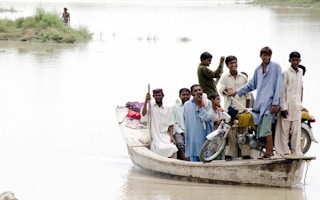In September, I marched along the streets of New York with impassioned climate activists calling for greater action on climate change. Their placards warned ‘the seas are rising and so must we’. A young woman, balanced atop a pillar, held one sign which said ‘I cant believe I’m protesting the facts’, and another ‘climate change is affecting vulnerable people most’.
We know this is the reality. 55 per cent of climate-related disaster deaths in Asia between 1997-2016 happened in the region’s four most fragile countries. That’s why on International Day for Natural Disaster Reduction we need to focus on supporting those at the frontline of climate-related disasters.
As conflicts become more protracted around the world, disaster risk reduction in contexts affected by violence, conflict and fragility will require a different approach.
Thirty years on from the initiation of the International Day, the intention ‘to promote a global culture of risk-awareness and disaster reduction’ is as relevant today as it was back in 1989. In 2019, the focus is on Target (d) of the Sendai Framework: to reduce disaster damage to critical infrastructure and disruption of basic services.
In Lebanon, conflict-displaced populations—whether those displaced 40 years ago from Palestine or in the last decade from Syria—live in conditions where critical infrastructure and basic services lack necessary protection against floods and winter storms.
Earlier this year, 600 displaced Syrians in refugee camps in the Bekaa Valley were relocated due to a harsh winter storm. Informal settlements along the coast were flooded, destroying people’s homes.
It is not yet the norm for disaster risk reduction (DRR) to be systematically integrated into post-conflict resettlement or reconstruction processes. That means that if risk creation continues, those living in post-conflict situations will remain vulnerable to the impacts of future natural hazards.
What would help mitigate the impacts is having an integrated cadre of experts that brings together those working on natural hazards, climate change and conflict prevention, in disaster- and conflict-prone contexts. But even then, there is more we can do.
“
As conflicts become more protracted around the world, disaster risk reduction in contexts affected by violence, conflict and fragility will require a different approach.
Here are six actions for accelerating DRR in conflict-affected contexts:
1. Getting the basics right: do no harm
Processes and principles such as ‘do no harm’ and conflict sensitivity are under-utilised in DRR programming, but need to be systematically incorporated into ways of working. In Afghanistan, NGOs use conflict analysis to inform the design of DRR interventions, and bring together experts in natural hazards and conflict prevention. Doing this ensures interventions and investments limit the negative impacts on conflict dynamics and support conditions for peace.
2. Conflict risks offer new entry points for DRR
Evidence from Lebanon suggests that community engagement in conflict risk management processes can offer new entry points for DRR. It could also advance our understanding of what types of DRR actions are viable in conflict contexts. For example, with the help of the Lebanese Red Cross, schools in Tripoli expanded their protocols to not only prepare for gunfire but also fire and earthquakes.
3. Maturing DRR to be politically astute
Disasters disproportionately affect the poorest in society, and DRR is not immune to political interference or conflict dynamics. DRR interventions and strategies from the national to the local levels must be conflict-sensitive. Donors should conduct reviews of DRR investment portfolios in line with conflict analysis, to better understand the interaction between disaster and conflict vulnerabilities.
4. Earmark funding to DRR in conflict contexts
A multi-donor pooled fund for disasters and peace could provide financial and technical support to agencies and states to develop capacity to enhance DRR in the most difficult operating environments.
5. Known unknowns: there’s so much more to learn
We must learn from affected people’s experiences, and better understand their coping capacities in the face of disaster and conflict risk. A formalised community of practice could share experiences, tools and techniques across agencies and governments.
6. DRR as a convenor for peace
While evidence suggests that ineffective disaster response exacerbates social conflict, we need to understand more about how DRR could improve relations between the state and its citizens, and bolster conditions for peace.
Just as the young climate activists called for action based on facts, if we’re serious about achieving the Sendai Framework by 2030, governments, donors and agencies need to urgently direct their attention to understanding the evidence around tackling disaster risk in conflict-affected contexts. Starting with these six ideas for action.
Katie Peters is a senior research fellow at the Overseas Development Institute.This story was published with permission from Thomson Reuters Foundation, the charitable arm of Thomson Reuters, that covers humanitarian news, climate change, resilience, women’s rights, trafficking and property rights. Visit http://news.trust.org/climate.











